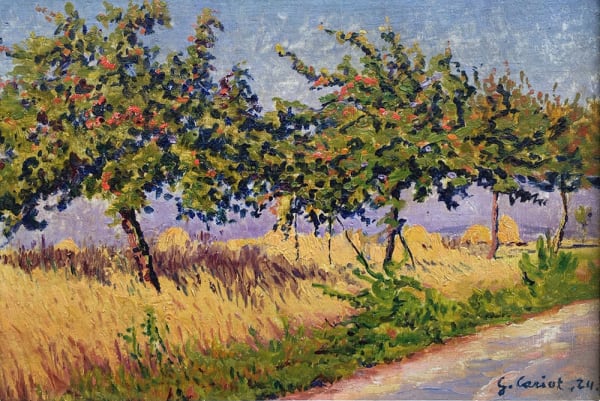20th century French artist Gustave Cariot was born in the Marais region of Paris in 1872. His father was a luggage-maker and encouraged Gustave to become his apprentice but the young Gustave insisted on pursuing an artistic career. As a youth he dedicated his spare time to drawing and sketching various views of the city and countryside.
Cariot went on to join the Société des Artistes Independants and began to exhibit in major Parisian exhibitions. In addition to showing with the Salon Nationale des Beaux-Arts, Cariot exhibited in the Salon d'Automne and the Salon d'Hiver.
Although he stopped short of wholly adopting the scientific theories of the Pointillists, Cariot was particularly interested in their technique. He also enjoyed exploring Divisionism's ability to communicate the luminescence and mutability of light and colour, although he never became a fully-fledged Neo-Impressionist.
He was greatly inspired by Monet's series of studies of Haystacks and of Rouen Cathedral, and in many ways his famous series of paintings depicting the Pont Neuf in Paris pay homage to this influence.
 Arbes fruitiers en fleurs, 1925Gustave Cariot
Arbes fruitiers en fleurs, 1925Gustave Cariot Les pommiers en fleurs, 1930Gustave Cariot
Les pommiers en fleurs, 1930Gustave Cariot Arbres en Bordure de Route, 1924Gustave Cariot
Arbres en Bordure de Route, 1924Gustave Cariot Village en Rhénanie, 1926Gustave Cariot
Village en Rhénanie, 1926Gustave Cariot Moisson, 1920Gustave Cariot
Moisson, 1920Gustave Cariot Gerbes de blé et arbres dans un champ, 1927Gustave Cariot
Gerbes de blé et arbres dans un champ, 1927Gustave Cariot Printemps à Gorgenborn, 1924Gustave Cariot
Printemps à Gorgenborn, 1924Gustave Cariot Le Verger, 1919Gustave Cariot
Le Verger, 1919Gustave Cariot Printemps, 1907Gustave Cariot
Printemps, 1907Gustave Cariot Bord de la Mer, 1901Gustave Cariot
Bord de la Mer, 1901Gustave Cariot
Send me more information on Gustave Cariot
Join our mailing list
* denotes required fields
We will process the personal data you have supplied in accordance with our privacy policy (available on request). You can unsubscribe or change your preferences at any time by clicking the link in our emails.














